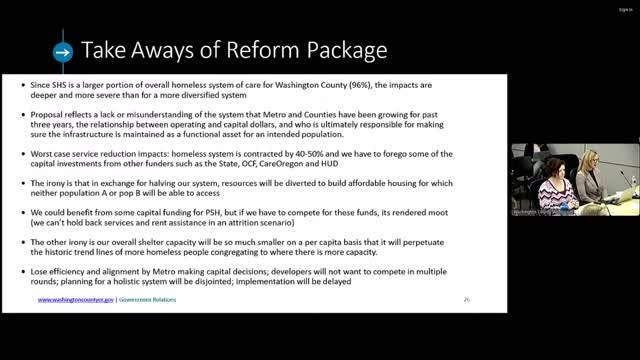Urgent call for housing solutions amid rising homelessness crisis
November 19, 2024 | Washington County, Oregon
This article was created by AI summarizing key points discussed. AI makes mistakes, so for full details and context, please refer to the video of the full meeting. Please report any errors so we can fix them. Report an error »

In a recent government meeting, officials discussed the pressing challenges facing the housing and homeless services system, emphasizing the need for a balanced approach to resource allocation. The conversation highlighted the importance of understanding capacity in terms of available beds, vouchers, and households supported by current resources.
One key point raised was the disparity in funding and service provision between different populations, specifically between those requiring immediate shelter (Pop A) and those needing deeper support services (Pop B). Officials expressed concern that a shift towards prioritizing affordable housing could inadvertently exclude vulnerable populations who rely on assistance to access these housing options.
The meeting also addressed the implications of potential funding cuts, particularly in temporary housing solutions, which could exacerbate existing inequalities among counties. Some areas have more shelter beds per capita, leading to a situation where individuals experiencing homelessness may be forced to migrate to these regions, further straining resources.
Officials noted the loss of efficiency that arises from having multiple decision-makers in the funding process, which can lead to project delays and a disjointed system. They stressed the need for a unified approach to capital investments and service operations to streamline efforts and improve outcomes for those in need.
Additionally, the meeting touched on the impact of recent changes in funding structures, which could limit the ability to support culturally specific organizations that serve local populations. This shift raises concerns about equitable access to resources and the potential for increased competition among organizations that have not traditionally operated in certain areas.
Looking ahead, officials are preparing to recommend funding for new access centers and transitional housing options, recognizing the critical need for these services as they navigate a complex funding landscape. The urgency of the situation was underscored by the fact that numerous households are currently seeking housing assistance, with many more waiting to be enrolled in support programs.
As the meeting concluded, the emphasis remained on the necessity of a coordinated response to the housing crisis, ensuring that all communities can effectively address the needs of their most vulnerable residents.
One key point raised was the disparity in funding and service provision between different populations, specifically between those requiring immediate shelter (Pop A) and those needing deeper support services (Pop B). Officials expressed concern that a shift towards prioritizing affordable housing could inadvertently exclude vulnerable populations who rely on assistance to access these housing options.
The meeting also addressed the implications of potential funding cuts, particularly in temporary housing solutions, which could exacerbate existing inequalities among counties. Some areas have more shelter beds per capita, leading to a situation where individuals experiencing homelessness may be forced to migrate to these regions, further straining resources.
Officials noted the loss of efficiency that arises from having multiple decision-makers in the funding process, which can lead to project delays and a disjointed system. They stressed the need for a unified approach to capital investments and service operations to streamline efforts and improve outcomes for those in need.
Additionally, the meeting touched on the impact of recent changes in funding structures, which could limit the ability to support culturally specific organizations that serve local populations. This shift raises concerns about equitable access to resources and the potential for increased competition among organizations that have not traditionally operated in certain areas.
Looking ahead, officials are preparing to recommend funding for new access centers and transitional housing options, recognizing the critical need for these services as they navigate a complex funding landscape. The urgency of the situation was underscored by the fact that numerous households are currently seeking housing assistance, with many more waiting to be enrolled in support programs.
As the meeting concluded, the emphasis remained on the necessity of a coordinated response to the housing crisis, ensuring that all communities can effectively address the needs of their most vulnerable residents.
View full meeting
This article is based on a recent meeting—watch the full video and explore the complete transcript for deeper insights into the discussion.
View full meeting
